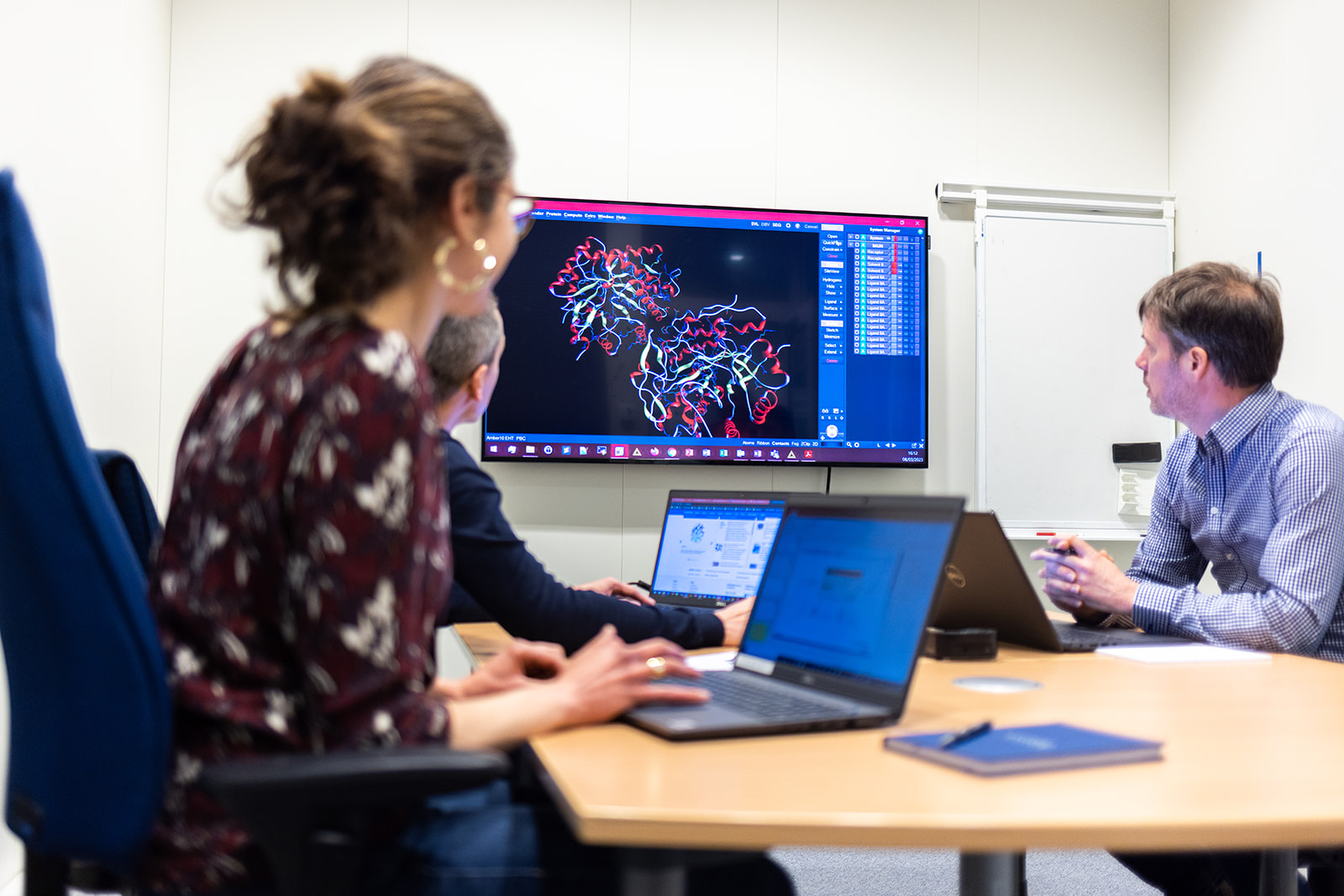


Using Computational Chemistry in Drug Discovery
Whithin the toolbox of the drug hunters, computer assisted drug design has taken a significant space in recent years. Computational power, algorithmic efficiency, and the accuracy of computational models is helping to reduce the time from bench to clinic of drug candidates. The possibility of performing in silico screening experiments has meant it is now possible to screen vast libraries of compounds for small molecules with therapeutic potential.1 Computer-aided drug design (CADD) and discovery has become nearly as commonplace as bench chemistry in pharmaceutical companies.
Computational chemistry can be used to accelerate throughput and minimize drug discovery timelines through several different approaches. Drug discovery in the laboratory typically starts with a high throughput screening (HTS) process where thousands of known compounds are tested for a desired set of reactions.
Once a compound that produces the desired set of effects is found, it is labeled as a hit. There may be further screening stages on the subset of hits selected from the original HTS sets. As testing and cell experiments can be slow and costly, each step of the screening process needs to be carefully optimized. While procedures are accurate and reliable enough to be meaningful, this is to ensure potential targets are not being missed.2
Automation experimentation, from automated analysis to sampling and sample preparation, has contribute to accelerate lab-based drug discovery attempts. Computational chemistry can be used in combination with guided lab-driven drug discovery.
Examples of approaches in computational chemistry
Two major approaches are conventionally used in CADD: the ligand-based drug design (LBDD) which is mainly based on data associated with small molecules in the absence of 3D structure of the target of interest, and the structure-based drug design (SBDD) which uses the 3D structure of a biological target to help in the selection and sorting of drug candidates.
Molecular dynamics simulations and high-level quantum chemistry methods are becoming more commonplace in computational chemistry for drug discovery. Molecular dynamics simulations can model how a system evolves over time, incorporating effects such as the conformational flexibility of systems and dynamical aggregation processes.4
Quantum chemical simulations are beneficial for calculating accurate binding energies. While the computational expense of many methods means there are some limits on the system sizes that can be treated, they typically offer something closer to chemical accuracy.
With such a variety of computational chemistry tools available and with several different codes – some of which require expensive licenses and highly specialized hardware to perform calculations on the scale required for screening and optimization – finding ways to take advantage of the opportunities offered by computational chemistry in your work can be challenging.
This is where Oncodesign Services, a contract research organization (CRO), is here to help. With extensive expertise in accelerating the small molecule Design-Make-Test-Analyze (DMTA), Oncodesign Services offers capabilities that will let you enjoy the benefits of computational chemistry without expensive training and infrastructure investments.
Discover Oncodesign Services Medicinal Chemistry platform
Oncodesign Services offers a full spectrum of drug discovery services. Much of this is underpinned by our integrated DRIVE-SM platform, which offers complete hit-finding, hit-to-lead, and lead optimization to IND solutions. DRIVE-SM makes use of computational chemistry, as well as some lab-based methods, to provide unique hit-finding and screening capabilities.
What Oncodesign Services offer with the DRIVE-SM plateforms is to find an optimal and customized strategy for hit identification. Using their extensive in-house expertise in areas such as computational chemistry, Oncodesign Services can offer de novo design with data-driven and artificial intelligence processes, as well as the study of structure-affinity relationships (SAR) in the hit-to-lead stages.
Once suitable candidates have been identified, and a therapeutic and activity profile has been established, Oncodesign Services can provide lead optimization and preclinical regulatory services. By drawing on the unique opportunities offered by supporting drug development with computational chemistry, Oncodesign Services has successfully delivered over 20 preclinical candidates in just the last few years and offered completion of IND-enabling study packages.
Oncodesign Services is a world-leading CRO specialized in Drug Discovery and preclinical research. Find out how Oncodesign Services’ innovative mindset and technical expertise can support accelerating your drug discovery pipelines and improve your hit rates.
-
References and Further Reading
- Sliwoski, G., Kothiwale, S., Meiler, J., & Lowe, E. W. (2014). Computational methods in drug discovery. Pharmacological Reviews, 66(1), 334–395. https://doi.org/10.1124/pr.112.007336
- MacArron, R., Banks, M. N., Bojanic, D., Burns, D. J., Cirovic, D. A., Garyantes, T., Green, D. V. S., Hertzberg, R. P., Janzen, W. P., Paslay, J. W., Schopfer, U., & Sittampalam, G. S. (2011). Impact of high-throughput screening in biomedical research. Nature Reviews Drug Discovery, 10(3), 188–195. https://doi.org/10.1038/nrd3368
- Reymond, J. L., Van Deursen, R., Blum, L. C., & Ruddigkeit, L. (2010). Chemical space as a source for new drugs. MedChemComm, 1(1), 30–38. https://doi.org/10.1039/c0md00020e
- Liu, X., Shi, D., Zhou, S., Liu, H., Liu, H., & Yao, X. (2018). Molecular dynamics simulations and novel drug discovery. Expert Opinion on Drug Discovery, 13(1), 23–37. https://doi.org/10.1080/17460441.2018.1403419


